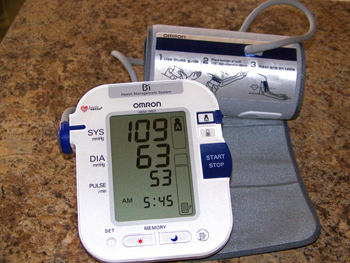Omron Automatic Blood Pressure Monitor Model HEM-790IT — Review
© 2011 Peter Free
30 January 2011

Works well, but monitor memory-to-computer software doesn’t work at all
These battery operated monitors facilitate one-handed use and eliminate the stethoscope that manual sphygmomanometers require.
The velcro-secured cuff has a notch for the right thumb and a bold, blue centerline that makes it easy to align it properly on the left arm. It’s a little clumsier to use on the right arm.
Hitting the start button pumps the cuff up and begins the automatic air release that ultimately results in a digital readout for systolic/diastolic pressure and pulse rate. The readout also shows the date and time the measurement was taken.
The monitor’s memory stores two people’s readings, so that they can be retrieved separately afterward.
However, the software that was designed to transfer this memory to a PC did not work at all on my Windows XP computer.
When contacted, it I had the impression that Omron knew about the problem, but was unwilling or unable to do anything about it. The filename for the software indicated that its creation long preceded the XP operating system.
Consequently, it makes more sense to buy the version of this Omron that comes without software.
Accurate for me
This model is reasonably accurate in its readings. They compare well with those that I take manually.
The Omron and manual readings also come out in the same range as those taken at physicians’ offices and with those the automatic machines one sometimes can use chain stores.
One should follow proper blood pressure-taking protocol
Before using a manual cuff or automated one, read up on the proper protocol for taking blood pressure and be sure the cuff is the right size for your arm.
Most medical technicians, nurses, and physicians take blood pressure incorrectly. The time constraints of busy office practices make it difficult not to.
For me and many other people, incorrect pressure-taking protocol almost always results in significantly higher pressures than the proper procedure generates. This can matter, if you want to avoid being put on medications that are not actually necessary. (Which, not so coincidentally, is why I bought my first manually-operated cuff decades ago.)
Recommended — but buy the model without the software (unless it claims to be compatible with your the exact version of your specifically named operating system)
It’s a nice tool. Mine came with a carrying case.
 PeteFree.com
PeteFree.com